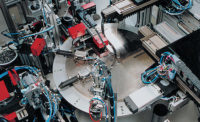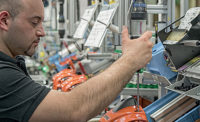Whether due to a bustling economy, reshoring, better technology or a skilled-labor shortage, manufacturers are automating more than ever.
According to ASSEMBLY magazine’s annual Capital Equipment Spending Survey, 89 percent of U.S. factories employed manual assembly processes in 2009, while only 17 percent used fixed automation. A decade later, those numbers are decidedly different. In 2018, 77 percent of factories employed manual assembly processes, but 31 percent used fixed automation.
What’s more, 29 percent of factories plan to purchase multistation automated assembly systems in 2019. That compares with 18 percent in 2018, and it’s the highest percentage since 2009. All totaled, sales of assembly systems are projected to increase 8 percent in 2019, to $800 million.
The automation boom is welcome news for systems integrators, but growing demand for automation has also led to a problem: Lead times for indexers, actuators, robots and other components have increased dramatically. Depending on the size and complexity of the part, delivery times for linear slides can range from 20 to 26 weeks; robots can range from 14 to 20 weeks; and indexers can take eight to 12 weeks.
“The typical lead time on certain product groups has increased from 50 to 100 percent in the past year,” says the purchasing manager at an integrator in the Southeast. “This is extremely problematic for us at times. We operate with no on-hand inventory, so it’s critical to have accurate deliveries from our supply chain. When [we can’t get components in a timely manner], it affects our lead time commitments to our customers.”
“We have definitely noticed lead times becoming longer for certain components,” says an engineer at a Midwestern integrator. “The two that stand out are aluminum extrusions and linear bearings. Lead times for extrusions have gone from days to weeks. Linear bearings can take upwards of nine months to a year. Extrusions are not as problematic, because we can find other vendors. Linear bearings, on the other hand, can be problematic.”
“Bowl feeders are the worst lead-time part we order,” says the lead designer at one Northeastern integrator. “Robots are not the worst, because we can order them early and by the time we need them, they usually show up. Bowls aren’t ordered until later in the design process, because they are a little more intimate with the overall machine design. The height and width of the bowl; counterclockwise vs. clockwise feeding motion; and the length of inline tracks and overhangs are all important features in our designs, because the closer the parts are, the faster cycle times are. And, good bowl guys are always swamped.”
Not every integrator agrees that there are lead-time problems. The president of one Southeastern integrator says his team is seeing “isolated incidents” of delays with some components, such as aluminum extrusions, linear bearings and vision cameras. “We can put our hands on most pipeline-model robots in less than six weeks,” he says.
While it might be tempting to blame tariffs for the increases in lead times, integrators say it’s mostly a matter of industry capacity.
“The amount of work within the automation sector has affected lead times from our suppliers,” says the marketing manager at a Midwestern systems integrator. “Integrators and machine tool builders are all vying for the same components. In many cases, we are at the mercy of each supplier’s production schedule and inventory.”
“The upturn in the economy has overwhelmed our current extrusion vendor,” says the engineer. “The company cut back when the economy was not doing well, and it did not successfully scale up production when things took off again.
“For linear bearings, China has played a major role. Chinese manufacturers are purchasing a lot of linear bearings, and making it very difficult to find vendors [without a backlog].”
Long lead times are not just an issue for integrators. They can be a problem for assemblers, as well. “The largest problem regarding lead times is when the item is a spare part. Often, the part is needed quickly, and the customer needs the exact part that was ordered previously,” says the engineer.
Adjusting to the Market
Lead times are a big deal for integrators, since designing and building an automated assembly system can take a while. A simple project might take 12 to 14 weeks. A complex one could take 48 to 52 weeks. With a large project, approximately 25 percent of the total project time will be spent on mechanical and electrical design and acquiring long-lead-time items. Another 25 percent will be spent actually building the machine; 25 percent will be spent debugging the machine; and 25 percent will be spent on final run off, tear down, shipping, installation and training. Anything that can shorten that timeline—and thus, help a customer get its product to market faster—is welcome.
It’s not surprising, then, that delivery time is a major consideration when choosing suppliers of automation components. According to a market research study conducted by ASSEMBLY magazine, 82 percent of engineers rank delivery time as an important factor when selecting components for an automation project. Only quality (96 percent) and service and support (93 percent) rate higher. Price is a distant fifth.
For a variety of reasons, integrators are often loyal to particular brands. Assuming their customers have no preference, integrators will specify those brands whenever possible. Integrators may prefer certain brands because they are more durable, reliable or easy to use. (One integrator prefers a particular brand of aluminum framing simply because it looks better.) In addition, working with a limited number of suppliers means engineers aren’t constantly relearning components. And, of course, brand loyalty can lead to favorable pricing.
However, delivery times are increasingly becoming a factor in the equation. Having more than one proven supplier gives integrators flexibility to specify a different brand if delivery times don’t match the project schedule.
“Lead times for machine components can be a wild card when developing a project schedule,” says the marketing manager. “Lead times are directly related to the market and saturation of work. For example, in the past we have received a weldment in eight weeks, but based on the capacity of our local suppliers, that lead time may jump up to 12 to 14 weeks.
“The variable of component lead times can be difficult to manage when quoting projects, especially those with compressed timing. To avoid these situations, we are engaged with multiple suppliers and distribute work accordingly based on their capacity.
“When ordering components for an assembly, those with extended lead times are flagged, and we either work with the supplier to improve those lead times, or we find an alternative.”
“We like to form long-standing relationships with our vendors, but at the end of the day, we need to get components in a timely manner,” adds the engineer. “In the short term, we have changed a few vendors due to long lead times. However, we will return to our original vendors if they are able to address the issue.”
Coping Strategies
Integrators can keep some components in stock, but that’s hard to do when building custom automation. Instead, integrators try to order long lead-time items as early as possible.
“As soon as we know linear components are needed, we look to see what is available and order it,” says the engineer. “We then make sure our design accommodates whatever is available—as opposed to the more standard process of designing the machine and then ordering according to the design.
“If a custom part is needed, but it has a long lead time, we may order both the custom version and a standard version of the part. We will then build the equipment with the standard version and use it until the custom part we really need is available.”
Communication goes a long way in ensuring components arrive in a timely manner.
“Our customers expect the same timing on our equipment no matter what is occurring in the marketplace,” says the marketing manager. “We communicate with our suppliers during schedule development to ensure their delivery matches what is agreed upon with our customers. Keeping suppliers up to speed with our forecasted projects helps them plan their production accordingly.”
“We work with our suppliers so they keep some stock of items about to be ordered for a project,” says the purchasing manager. “Our top suppliers work with our design and build teams on the bills of materials for projects to see if they can suggest items that would have shorter lead-times.”
“Many times, we are able to leave the overall project timeline unchanged because we can accommodate long lead times with workarounds,” adds the engineer. “In these cases, the lead times are harder on our internal team than our customer. That said, we keep our customer in the loop.”
“We consider supply chain risks in our designs, dividing the system into modules that can be built and tested as much as possible without certain high-risk components,” says the president. “We also identify long lead-time or high-risk components early in the process, so we can freeze design parameters and order those components early.”
Fortunately, integrators don’t have to wait for certain components before starting work on a machine. For example, if extrusions are the hold up, engineers may be able to build the station and then add the machine guarding later.
“It depends on the complexity of the machine and how critical the component is to the final process,” says the purchasing manager. “We can release fabricated components ahead of long-lead items. We can build up panel enclosures with all the electrical components, so we can program and debug as soon as long-lead items come in.”






